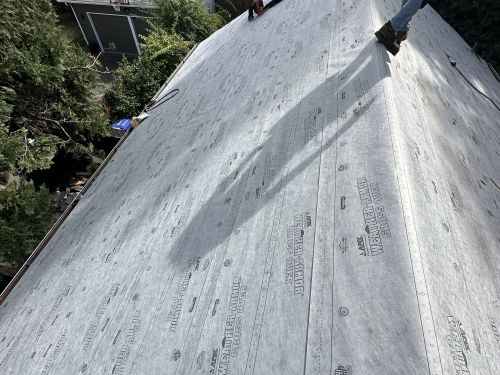Understanding Roof Underlayment: Your Home’s Hidden Waterproof Barrier
When it comes to protecting your home in Oregon’s rainy, moisture-heavy climate, few roofing components play a more critical role than roof underlayment. Often hidden beneath shingles, metal panels, or tiles, the underlayment provides a waterproof barrier that prevents moisture intrusion, wood rot, and structural damage. Because it’s not visible from the exterior, many homeowners don’t realize its importance—or that it can fail over time. Knowing how to identify damaged roof underlayment and when it needs repair or replacement is essential for preserving the longevity of your roof.

Need to have Your Roof Inspected?
What is Roof Underlayment?
Roof underlayment is a protective layer installed directly over the roof decking before the final roofing material is applied. In Oregon, where rain, wind, and moisture are frequent, underlayment acts as a secondary defense against leaks. Common types include:
- Asphalt-saturated Felt
- Synthetic Underlayment
- Rubberized Asphalt (ice and water shield)
Regardless of the type, its purpose remains the same: keeping water out, improving roof durability, and providing a barrier that protects your home from long-term moisture damage.
Why Roof Underlayment Fails in Oregon’s Wet Climate
Oregon’s climate presents unique challenges that can wear down roofing systems faster than in drier regions. The constant cycle of moisture, wind-driven rain, and seasonal temperature changes gradually diminish the integrity of roof underlayment.
Persistent Moisture Exposure
With long rainy seasons and damp air, moisture can slowly penetrate roofing materials. If shingles lift, crack, or become displaced, the underlayment becomes the first point of contact with water—causing it to degrade, buckle, or rot.
Heat Expansion and Contraction
Though Oregon is known for cool weather, summer heat still causes expansion in roof materials. Seasonal temperature swings create stress that eventually leads to cracking, thinning, or separation of the underlayment.
Mold and Mildew Growth
Humidity encourages mold and mildew between roof layers. Over time, this microbial activity weakens the underlayment fibers and leads to premature failure.
Wind Uplift and Storm Damage
Strong coastal winds or seasonal storms can tear shingles or force water underneath roofing layers, stressing the underlayment and accelerating deterioration.
If you suspect that your underlayment has been compromised, or if your roof is over 20 years old, it’s time to get a professional evaluation. HER Roofing offers comprehensive roofing inspections to help homeowners identify hidden moisture damage before it becomes a major issue.
Signs Your Roof Underlayment Needs Repair or Replacement
Although underlayment is not visible without lifting the roofing material, there are several signals homeowners can watch for. These warning signs should never be ignored:
Interior Water Stains
Brown stains on ceilings or walls are one of the most common indicators of failing underlayment. Even small leaks often point to deeper moisture issues beneath the roof’s surface.
Mold or Musty Odors in the Attic
If your attic smells damp or shows signs of mildew, moisture may be seeping through compromised underlayment.
Curling or Missing Shingles
Shingle problems often mean that water has reached the layer below. Once exposed, underlayment can warp, crack, or deteriorate quickly.
Soft Spots or Sagging Roof Decking
Soft or sagging areas of the roof indicate trapped moisture—a sign the underlayment is no longer providing sufficient protection.
Increased Energy Bills
Damaged underlayment can affect roof ventilation and insulation efficiency, causing your heating and cooling costs to rise.
If you notice any of these symptoms, scheduling a professional roof inspection is crucial. HER Roofing’s certified technicians can assess damage, recommend solutions, and ensure your underlayment is replaced correctly.
The Process of Replacing Damaged Roof Underlayment
Repairing damaged underlayment involves several steps, each requiring precision to ensure long-term protection:
- Full Roof Inspection: A roofing professional evaluates the extent of damage above and below the roof surface.
- Shingle or Roofing Material Removal: The top layer is carefully removed to expose the underlayment.
- Underlayment Replacement: Damaged sections—or the entire layer—are replaced with high-quality synthetic or rubberized materials designed to withstand Oregon’s climate.
- Reinstallation of Roofing Materials: Shingles or panels are reinstalled, sealed, and secured.
- Final Waterproofing and Quality Check: The roof is inspected again to ensure durability and proper moisture protection.
This process ensures that your roof continues to defend your home from water intrusion for years to come.
Protect Your Home With Quality Roof Underlayment
Damaged roof underlayment can lead to costly interior repairs, mold growth, and structural issues. Being proactive about inspections and maintenance ensures your roof stays strong against Oregon’s wet climate.
Ready to protect your home? Contact HER Roofing today for a professional inspection and expert underlayment replacement services.

